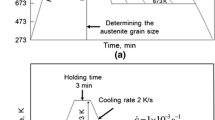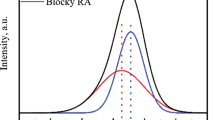Abstract
In this paper, the authors electrolytically extracted niobium inclusions from heats of 1030 steel with FeNb, NbO2, and NbO additions. From energy-dispersive spectroscopy, the inclusion chemistry of these additions was found to be similar. Pure niobium oxide inclusions were never found in the steel. Inclusion size was measured using polished samples and electrolytically extracted samples. Statistical analysis found that the average inclusion size was larger on filtered samples compared to the polished samples. Since pure NbO inclusions were not found, it was thought that the niobium strengthening reported in the earlier literature might be actually due to a precipitation hardening effect. Precipitation heat treatments were done at 600, 625, and 650 °C (1112, 1157, and 1202 °F) after solutionizing at 1100 °C (2012 °F). The hardness was measured at aging times of 30, 45, 60, 75, and 90 min. The observed relation between hardness and aging time matched that expected for a precipitation hardening mechanism. It was therefore theorized that the NbO and NbO2 additions dissolved in the melt and form precipitates.








Similar content being viewed by others
References
B. Bramfitt, The effect of carbide and nitride additions on the heterogeneous nucleation behavior of liquid iron. Metall. Trans. 1, 1987–1995 (1979)
R.B. Tuttle, Effect of NbO additions on the grain size of 1010 steel castings. J. Mater. Eng. Perform. 22(1), 145–151 (2013)
M. Imagumbai, H. Kajioka, H. Takechi, Application of Nb-O affinity in clean steel. Mater. Sci. Forum 500–501, 559–564 (2005)
H. Mohrbacher, The effect of niobium microalloying in second generation advanced high strength steels, in International Steel Technologies Symposium, Kuohsiung, Taiwan, (2008)
S.L. Shrestha, Y.K. Xie, C. Zhu, P.S. Ringer, C. Killmore, K. Carpenter, H. Kaul, J.G. Williams, J.M. Cairney, Cluster strengthening of Nb-microalloyed ultra-thin cast strip steels produced by cast strip process. Mater. Sci. Eng. A 568, 88–95 (2013)
J. Campbell, Castings practice: the 10 rules of castings (Elsevier, Oxford, 2004), p. 11
A. Karasev, Y. Bi, P.G. Jonsson, Three-dimensional investigation of large-size inclusions and clusters in steels by using the electrolytic extraction technique, in AIStech Proceedings (2013), pp. 1139–1145
W.D. Callister, D.G. Rethwisch, Material science & engineering-an introduction, 9th edn. (WileyPLUS Publishing Co., NewYork, 2013), pp. 388–391
F.L. Xiao, Y. Cao, G. Qiao, X. Zhang, B. Liao, Effect of Nb solute and NbC precipitates on dynamic and static recrystallization in Nb steels. Int. J. Iron Steel Res. 19(11), 52–56 (2012)
T. Galdman, The physical metallurgy of micro alloyed steels (Maney Publishers, Oxford, 1997)
Acknowledgments
The authors acknowledge the financial support of the Office of Naval Research under Award Number N 141410740. The authors also wishes to thank Jacob Sharpe and Phillip Messing in assisting with conducting the foundry experiments and preparing the samples.
Author information
Authors and Affiliations
Corresponding author
Technical Review and Discussion
Technical Review and Discussion
Role of Niobium Oxides on the Strength of Plain Carbon Steels
Aravinda Bommareddy, Robert B. Tuttle; Saginaw Valley State University, University Center, MI, USA
Reviewer:
The paper title mentions strength, but there isn’t “strength” data in this paper.
Authors:
The strength refers to the hardness data of the 1030 steel samples with additions of niobium, it is not meant to tensile strength.
Reviewers:
It would be helpful to add the particle size of the oxide powders, e.g., 325 mesh (~44 µm).
Authors:
We do not have a complete size distribution of the oxide powders. This is not supplied by the manufacturer and we do not have the capability to measure the size distribution at such a small particle size. A −325 mesh does mean that the particles are 325 mesh and smaller. For foundry sand sieve analyses this is actually pan material.
Reviewer:
Regarding Figures 6, 7, and 8: The data of baseline samples (1030 without Nb additions) should be provided to confirm the Nb precipitation hardening mechanism.
Authors:
The hardness of the baseline under the same conditions was only 7 HRC. It did not really change as a function of aging time. This is consistent with the formation of martensite and tempering than it is with a precipitation hardening mechanism. The authors have clarified this in the final document.
Reviewer:
As indicated in the paper, the analyzed particles (Figure 5) are different from the particles added into the steel liquid stream. What is the Nb content within the matrix and at grain boundaries?
Authors:
The overall niobium content is part of Table 1 . EDS analysis of the matrix did not indicate the presence of niobium in the steel which is not surprising since an element needs to be on the order of 0.1–0.5 wt% for EDS to detect it. Therefore, we cannot determine the Nb content of the matrix or at the grain boundaries.
Reviewer:
The paper indicates that NbC precipitates were considered critical for strengthening. NbC precipitates micrographs should be provided in the paper.
Authors:
Niobium carbonitrides are very well documented in the open literature and require conducting TEM work to image them and verify the phase. These precipitates are on the order of several nanometers which is why they cannot be imaged in an optical microscope or SEM. While SVSU has a TEM, it does not have EDS capability to verify the precipitate composition and it is not capable of producing the required high resolution TEM images.
Rights and permissions
About this article
Cite this article
Bommareddy, A., Tuttle, R.B. Role of Niobium Oxides on the Strength of Plain Carbon Steels. Inter Metalcast 10, 208–215 (2016). https://doi.org/10.1007/s40962-016-0028-4
Published:
Issue Date:
DOI: https://doi.org/10.1007/s40962-016-0028-4




